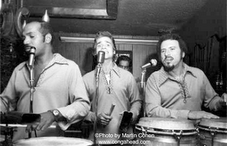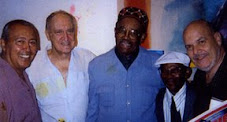
All this had actually begun a few nights earlier, when after an all-night party, I had left
I had arrived in
Several days later, I mentioned casually to a student friend that I had been having difficulty reading Dr. Fernando Ortiz and Orifiche. I was struggling with the Lukumi vocabulary and negligible Spanish. He suggested crossing over to Regla to meet Juan Beson. There may still be people who remember this most influential babalao, with his tall, thin noble stance and his solitary front tooth that, like a badge, evinced a certain sincerity.
“What is he up to?” I wondered, as I stood back watching him light some candles. “He is invoking La Virgen de Regla, asking for protection for your house,” said my friend. The babalao was responding to the answer I had given him when he asked me, “Why have you come here?” (This is the same question a psychologist asks a new patient.) I was unprepared with a reply and with Ñañigo proverbs traveling Quixote-like around my brain, I was about to confess that it was not my intention to come…that my friend had suggested it…when I stammered…“la…la música.”
At that moment, the night surrounding us seemed to physically withdraw itself in respectful silence. From this tableau of a babalao, a young American and his Cuban friend, a trinity emerged like three magi in a holy night. As I received his blessing, I felt that he knew very well why I had come to Regla. “You will carry this music around the world,” he said. Was this a prophesy, or a command of sorts? Was it an example of his psychic insight? Whatever the meaning, it has influenced me all my life…of that there is no doubt. Knowing absolutely nothing of the technicalities of music, but now much imbued with the workings of its mysterious power. Was I to go forth like a neophyte apostle, an evangelist proselytizer?
Much shaken by this truly religious experience, I wondered: Was his odd statement merely an example of lyrical rhetoric? And example of pastoral eloquence, an embellishment of a ritual, a divinely inspired assignment? A fortuitous indoctrination, a revelation that made me a propagator of this music? A step toward my greater spiritual education, a sacred covenant, an oracular portent? An inescapable aesthetic responsibility that made me involved, indebted, privileged? A canonization witnessed by invisible Orishas, an unexpected imposition that made me an instrument of the music itself? Was the santero a channeler between Yemaya and a new convert?
After this encounter, one fact emerges from the overall picture of my life. I can see that I have faithfully “carried the music around the world.” Returning from Cuba in 1941, I opened dance studios all along Miami Beach; performed with the La Playa Dancers around the United States; exhibited rumba with the USO in Samar, Phillipines; run the Champagne Dance Contests aboard cruise ships; lead the immensely popular conga lines of the 1950s; taught with Tony and Lucille Colon at Grossinger’s; lectured oral history of the music at the Smithsonian; and donated my poster collection of Latin orchestras to Boys Harbor. I was given a dream in Regla that today I see slowly materializing into reality, like a plant I have watered. Surely we make the world a better place with this happy music…a duty that is set before all mankind…is it not? So it was foretold that I would one day write this for you to read.

